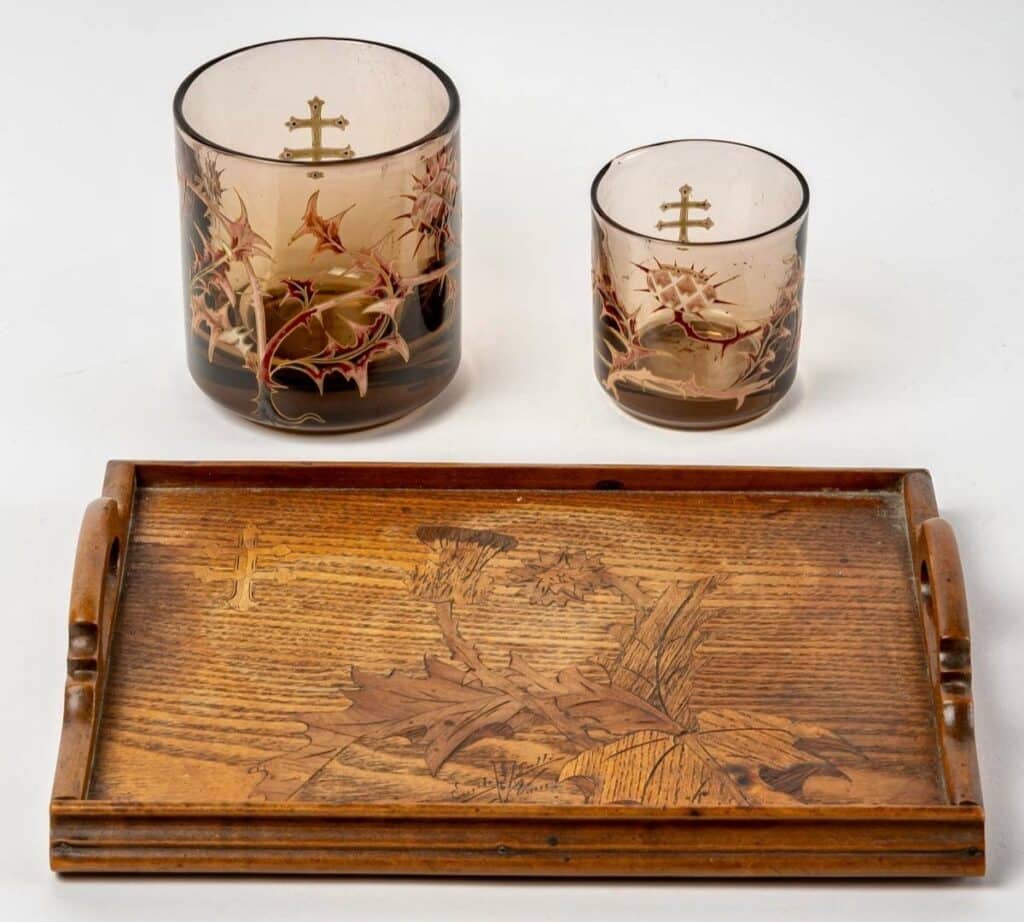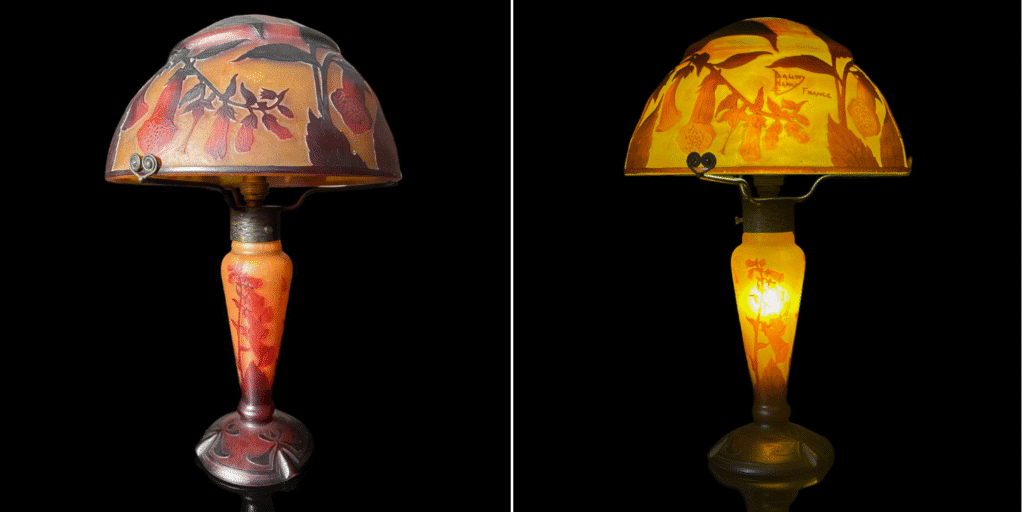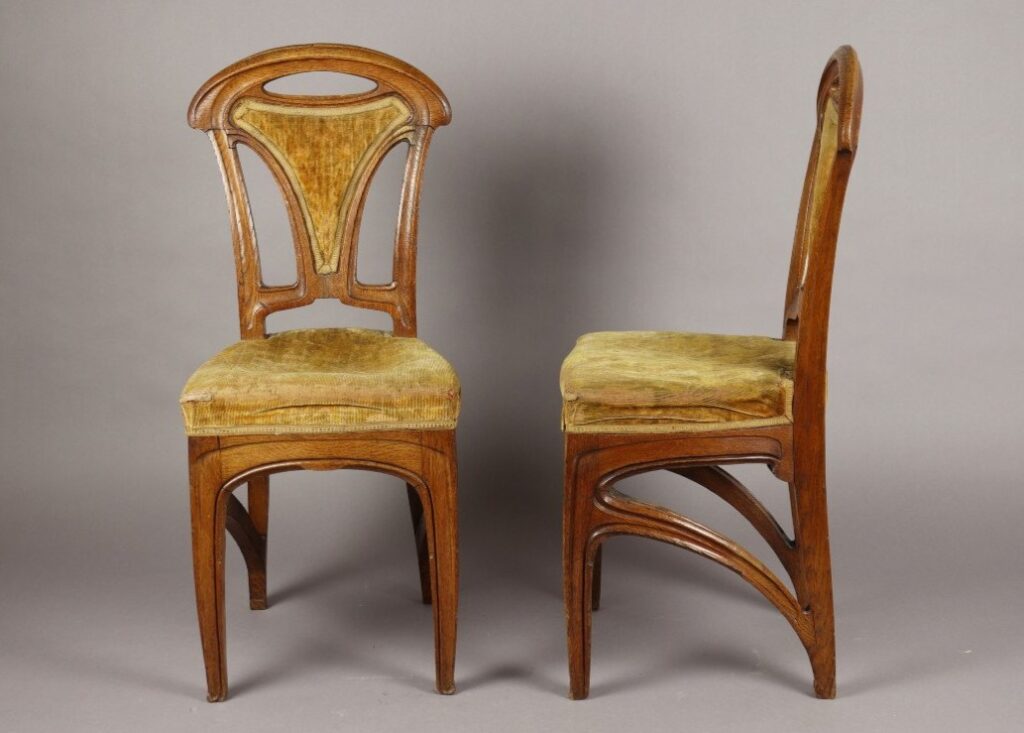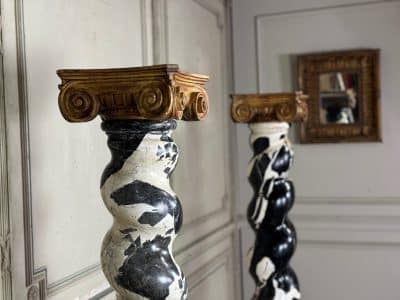Explore the origins of the École de Nancy (The Nancy School), the visionary artists who brought it to life (Gallé, Majorelle, Daum, and others), and the exceptional craftsmanship in furniture and glassware that became their hallmark.
The capital of Art Nouveau in France is Nancy—a remarkable exception in a country so deeply centralized around Paris in nearly every sphere, especially culture. Of course, we’re not saying that Paris played no role in Art Nouveau. Major figures such as Hector Guimard, Alphonse Mucha, and Siegfried Bing were highly active there. But Nancy—especially with the creation of the École de Nancy—became the driving force in France behind this richly decorative and all-encompassing art form that is Art Nouveau.
Origins: From Parisian Triumphs to Nancy’s Awakening
The École de Nancy did not appear out of thin air. Its roots can be traced back to the spectacular successes Lorraine artists achieved on the international stage at the end of the 19th century.
At the 1889 Paris Universal Exposition, Émile Gallé won a Grand Prix for glass, a gold medal for ceramics, and a silver medal for furniture. These prizes were not only personal victories but also a collective recognition of Lorraine’s emerging decorative arts scene. Louis Majorelle, another key figure, also drew attention with his finely crafted furniture, inspired by both tradition and natural forms.

Smokers set by Emile Gallé: two glasses and an inlaid tray, each one carrying the cross of Lorraine and a thistle, two symbols of Lorraine and Nancy. At a time when France was reeling from the loss of Alsace and part of Lorraine following the defeat of 1871, these symbols struck a deep chord in the nation’s heart. © BG Arts
The momentum carried forward to 1894, when Nancy hosted its own Exposition of Decorative and Industrial Arts at the Galeries Poirel. More than seventy local artists presented their work together for the first time, creating a sense of collective identity. This exhibition, organized under the Société des Arts Décoratifs Lorrains, is often described as the true “founding act” of the École de Nancy. It gave Lorraine’s artists a platform to assert themselves not as isolated creators but as members of a cohesive movement.
By 1901, Gallé formalized the idea. In open letters published in local newspapers, he called for a union of artists and industrialists to promote Lorraine craftsmanship and resist foreign competition. His appeal resonated. That February, the Alliance Provinciale des Industries d’Art, soon known simply as the École de Nancy, was officially founded. Gallé became president, Majorelle and Antonin Daum vice-presidents. A movement was born, rooted in collective ambition and civic pride.
A French Art Nouveau with a Lorraine Accent
At the dawn of the 20th century, Art Nouveau swept across Europe. In Belgium, Victor Horta transformed architecture with organic ironwork; in Vienna, the Secessionists embraced geometric purity; in Scotland, Charles Rennie Mackintosh merged minimalism with symbolism. France had its own epicenter in Paris, where dealers like Siegfried Bing popularized Art Nouveau through luxury objects and fashionable interiors.
But Nancy took a different path. Here, Art Nouveau was not simply about style — it was about purpose. In a city scarred by the 1870 Franco-Prussian War (with the loss of Alsace and a part of Lorraine) and perched on the new German border, Lorraine artists infused their work with a sense of patriotism and resilience. They envisioned art as a tool of renewal, a way to prove that the provinces could rival Paris and that beauty could uplift society.

A 16.5-cm cameo vase by Daum, circa 1900. Acid-etched and enameled Lorraine landscape. Internal and superficial powder vitrifications. © Art Glass Nancy 1900
The École de Nancy sought to break down barriers between so-called “major” and “minor” arts. Glass, furniture, ceramics, stained glass, wrought iron — all were given equal dignity. Inspiration came overwhelmingly from nature: thistles, dragonflies, ginkgo leaves, and water lilies became recurring motifs.
Unlike Parisian Art Nouveau, often confined to elite salons, Nancy’s version carried a democratic ideal. Its motto could be summed up as “art for all.” The movement sought to place beauty within reach of everyday households, while maintaining exceptional craftsmanship. It was both a regional response to Parisian dominance and an international statement: Nancy would be the French capital of Art Nouveau beyond the capital itself.
Émile Gallé: Nature, Poetry, and Social Conscience
If the École de Nancy had a soul, it was Émile Gallé (1846-1904). Trained in botany, literature, and science, Gallé was more than an artist: he was a poet, a scholar, and an activist. His glasswork — cameo pieces etched with multiple layers, often depicting plants or insects — transformed utilitarian objects into lyrical tributes to nature. Dragonflies hovered across translucent surfaces; thistles and umbels stretched along vases like pressed flowers in glass.
Gallé also reinvented furniture. His marquetry desks and cabinets, like the celebrated Bureau aux Ombelles, featured carved wood panels with botanical motifs and asymmetrical forms that mirrored the irregular rhythms of nature. For Gallé, furniture was not static utility — it was sculpture with meaning.

Art Nouveau desk with umbellifer flowers and a dragonfly by Emile Gallé. Solid walnut with Rio and Burmese rosewood inlays. © Antiquités Art Nouveau
But Gallé’s art was never apolitical. He infused his work with messages on justice and human dignity. He dedicated pieces to the Irish independence movement, denounced the Armenian massacres in the Ottoman Empire, and openly supported Alfred Dreyfus during France’s most divisive political scandal. His “talking furniture” and symbolic glassware were vehicles for conscience as much as for beauty.
As the first president of the École de Nancy, Gallé embodied its ideals: a fusion of technical innovation, poetic naturalism, and social engagement. His premature death in 1904 was a heavy blow to the movement, but his legacy set the tone for everything the École sought to achieve.

Rare flask by émile gallé with a decor of blackthorn berries and fruits, in triple-layered glass, acid-etched in cameo relief on an opalescent yellow background. © Pascal Berro
Louis Majorelle: Furniture as Living Sculpture
If Gallé was the poet, Louis Majorelle (1859-1926) was the architect of daily life. Born into a family of cabinetmakers, Majorelle inherited his father’s workshop and transformed it into one of the most successful decorative art firms in France. His early work echoed Gallé’s naturalistic marquetry, but by 1900 he had developed his own voice: fluid, sculptural furniture where form itself became decoration.
The Nénuphars ensemble, unveiled in 1900, epitomized this shift. Majorelle emphasized sinuous lines, letting wood and bronze fittings flow together in organic unity. Unlike earlier ornate marquetry, his designs privileged structure, showing that simplicity could be more modern than excess. The period that best represents his style spans 1902 to 1906.

A mahogany buffet by Louis Majorelle, carved with pine cones. Pine cones were one of Majorelle’s favorite motifs, present, for instance, in the living room of the Villa Majorelle. © Art Revival
Majorelle’s crowning achievement was the Villa Majorelle, his own home built in 1901–1902 with architect Henri Sauvage. It was the first fully Art Nouveau house in Nancy: a total work of art where stained glass by Jacques Gruber, ceramics by Alexandre Bigot, and Majorelle’s own furniture blended seamlessly. Visitors to the dining room could admire the unity of architecture, decoration, and lifestyle. The concept of “total art” was not abstract in this villa—it was lived reality.
International success followed. Majorelle opened shops in Paris, London, and beyond, exporting Lorraine’s Art Nouveau to the world. After World War I, he evolved toward Art Deco, proving his adaptability. Yet the sensual elegance of his Art Nouveau furniture remains his most enduring contribution, a balance of grace and practicality.
The Daum Brothers: Alchemists of Glass
While Gallé infused glass with poetry, the Daum brothers gave it technical revolution. Jean Daum’s sons, Auguste and Antonin, transformed their family’s glassworks into a powerhouse of Art Nouveau innovation. Inspired by Gallé but eager to experiment, Antonin created a dedicated artistic department in the 1890s. Like Gallé, the Daum brothers had mastered the art of cameo glass, engraved with a wheel or etched with acid.
Their big breakthrough came with the rediscovery of pâte de verre, an ancient technique of casting glass using lost-wax molds. By melting fragments of colored glass (groisil) in plaster molds at high heat, Daum achieved astonishing textures and shades. No two pieces were identical. The results looked less like industrial products than like crystallized sculptures of light.

An acid-etched cameo glass lamp by Daum, crafted around 1915. The digitalis flowers and stems are in shades of red, orange, and brown against a yellow background. © Verre 1900
Several major artists worked for Daum. The first, Jacques Gruber, was recruited in 1893. Henri Bergé, hired in 1895, became a key designer, renowned for the quality of his draftsmanship and his remarkable botanical knowledge. From 1904 to 1915, Amalric Walter spearheaded the development of pâte de verre.
Daum’s success was crowned at the 1900 Paris Exposition Universelle, where the firm shared a Grand Prix with Gallé. From then on, Daum became synonymous with innovation, producing thousands of models between 1890 and 1914. Their lamps, often created in collaboration with Majorelle’s wrought iron, perfectly embodied the Nancy ideal of cross-disciplinary unity.
Unlike Gallé, who died early, Antonin Daum (1864-1930) survived well into the 20th century, adapting to Art Deco and maintaining international prestige. To this day, the name Daum evokes mastery of glass — an enduring legacy of the École de Nancy.
Furniture: An Art Nouveau for Everyday Life
Furniture was central to the École de Nancy’s vision of “art in the home.” Far from being limited to elite showpieces, Nancy’s artists imagined entire interiors where beauty and utility coexisted. Dining rooms, bedrooms, salons — every element could be harmonized through design.
Majorelle was the most prolific furniture maker, his workshop producing pieces that combined sculptural forms with bronze fittings. While initially influenced by Gallé’s marquetry, he progressively moved toward furniture where the lines and sculptural qualities of the wood became more important than decorative inlays. Émile Gallé created symbolic, poetic furniture that carried inscriptions and imagery, turning desks and cabinets into manifestos of thought.

Pair of oak chairs by Eugène Vallin, a master of Art Nouveau at the Ecole de Nancy. Original upholstery. © Art Revival
But Majorelle and Gallé were not alone. Eugène Vallin, both architect and cabinetmaker, integrated flowing wooden structures into his buildings, blurring the line between furniture and architecture. Camille Gauthier, a younger figure, also made his mark by producing elegant yet practical pieces that embodied the democratic ideals of the École — artful design made to serve everyday households.
Even utilitarian items like chairs or wardrobes were designed with elegance in mind. In this way, the École de Nancy differed from Parisian Art Nouveau, which often produced spectacular one-off pieces. In Lorraine, the goal was a coherent lifestyle, where everyday objects carried the grace of nature.
Glass: The Soul and Transparency of Nancy
If furniture grounded Nancy’s Art Nouveau in daily life, glass gave it wings. The region’s abundance of raw materials and traditions of crystal-making in Lorraine made glass the perfect medium for artistic experimentation.
Gallé elevated glass to poetry, layering colors, carving silhouettes of flowers, insects, and landscapes. His pieces often contained hidden meanings, literary references, or political allusions. Each vase or lamp was both an artwork and a message.
Daum, by contrast, emphasized technique and variety. Acid etching, wheel engraving, cameo layers, and above all, pâte de verre allowed the firm to multiply effects and adapt to different markets. Their lamps, created with Majorelle’s ironwork, became icons of Nancy’s Art Nouveau.

Stained glass transom with nasturtiums. Attributed to Jacques Gruber as it was part of a lot signed by Gruber. The flowers are made of double-layered glass, etched with acid, and the leaves are painted with grisaille. The whole piece is set in lead. © L’Antiquaire du Vitrail
Jacques Gruber, first as Daum’s designer and later as an independent stained-glass master, brought light into architecture itself. His windows for villas and public buildings translated the same organic motifs into colorful transparency.
Together, these contributions made glass the soul of Nancy’s Art Nouveau. Fragile yet luminous, it symbolized the movement’s ideals: natural beauty, technical mastery, and a touch of magic.
Other Figures: The Collective Spirit of the École de Nancy
Though Gallé, Majorelle, and Daum were the stars, the École de Nancy thrived on collaboration.
Victor Prouvé (1858-1943), a painter and sculptor, succeeded Gallé as president and infused the movement with humanist ideals. He often worked with Gallé, providing figurative motifs for vases and furniture that carried political messages. In the art of bookbinding, his works were created in collaboration with Camille Martin and René Wiener.
Eugène Vallin (1856-1922) not only built furniture but also designed buildings that embodied Art Nouveau principles, from flowing façades to harmonious interiors. His work confirmed that the École de Nancy was about architecture as well as decoration.
Jacques Gruber (1870-1936), one of the first artists employed by Daum, went on to become one of France’s greatest stained-glass masters. His colorful windows adorned both private villas and public institutions, spreading the vocabulary of Nancy’s Art Nouveau across Europe.

Art Nouveau ceramic pitcher by Ernest Bussière made by Keller & Guérin in Lunéville and sold by Majorelle. With a sophisticated organic shape. © Galerie Origines
Equally important, Ernest Bussière (1863-1913) gave the movement a strong ceramic dimension. His sculptural vases and busts, often adorned with natural motifs, brought the vitality of Art Nouveau into clay and stoneware. In his hands, ceramics became another medium for expressing the organic rhythms of nature.
These figures, and many others, ensured that the École de Nancy was never just about individuals. It was about a community of artists and craftsmen, united by the conviction that art could transform life.
Conclusion: From Bloom to Decline
Like all avant-garde movements, the École de Nancy had its moment of glory and its decline. Gallé’s death in 1904 deprived the group of its visionary leader. Tastes shifted after 1910, as the exuberant curves of Art Nouveau gave way to the sharper lines of Art Deco and the functionalism of modern design. The 1909 Exposition internationale de l’Est de la France in Nancy was the last official display of the École de Nancy. The devastation of World War I further disrupted Lorraine’s industries and markets.
Yet the École’s legacy is profound. It showed that art could be democratic, integrated into everyday objects, and rooted in regional pride. Its emphasis on the unity of the arts anticipated later movements like the Bauhaus. Its masterpieces — Gallé’s poetic glass, Majorelle’s sculptural furniture, Daum’s luminous pâte de verre — continue to attract collectors and inspire designers.
Today, the Musée de l’École de Nancy preserves this heritage. This museum is housed in the former home of Eugène Corbin (1867–1952), founder of the Magasins Réunis and an early and generous patron of the École de Nancy. It reminds us of a time when artists believed beauty could heal wounds, elevate society, and illuminate daily life. The École de Nancy may have been provincial, but its vision was universal: to bring art into the hands, and homes, of all.











